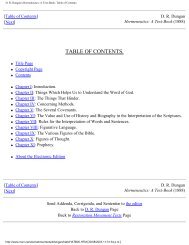Dungan - Hermeneutics
The Art and Science out interfering scripture.
The Art and Science out interfering scripture.
Create successful ePaper yourself
Turn your PDF publications into a flip-book with our unique Google optimized e-Paper software.
D. R. <strong>Dungan</strong>'s <strong>Hermeneutics</strong>: A Text-Book: Table of Contents.<br />
SEC. 34. THE DOGMATIC METHOD. (1) Noted for (a) assumption, (b) supposing all true<br />
that may be proved. (2) Came into existence during the dark ages. (3) Has been<br />
kept alive by ignorance and credulity, on the one hand, and the desire to rule, on the<br />
other. (4) Began in Catholicism and is continued in Protestantism. (5) Some truth has<br />
been found by it. (6) Not because the Scriptures speak in riddles. (7) It exalts<br />
traditions to an equality with the word of God. (8) Now hinders Christian unity. (9)<br />
The Bible not a book of proof, but the teaching of God to men. Immer's<br />
<strong>Hermeneutics</strong>. (10) The way doctrines are proved. (11) It finds in the Bible only<br />
what it wishes to find. (12) Liberalism adopts this method. 73<br />
SEC. 35. LITERAL INTERPRETATION. (1) Used by dogmatists generally. (2) Makes all the<br />
Bible literal. Sometimes assumes meanings which the words in question never have. 79<br />
SEC. 36. THE INDUCTIVE METHOD. (1) What is it? Bacon. (2) The law of analogy. (3) All<br />
facts are reported--four particulars. (4) To heed this rule is sometimes difficult. Get<br />
all the facts, if possible; get as many as may be gathered; treat them justly. Test of<br />
Christianity and of certain laws. (5) This method used generally, except in theology.<br />
(a) Blackstone. (b) Witnesses in court. (c) Teachers of science. (d) Political<br />
economists. (e) The Bible recognizes the correctness of this method. (6) Inference<br />
may be used, if legitimate. (a) Abraham and Lot came out of Egypt. (b) The four<br />
kings. (c) King of Jericho, and other kings. (7) Things assumed in the Bible are true.<br />
(a) Man's responsibility. (b) An honest heart needed. (c) His general wants. (8)<br />
Causes understood when results are named. (9) Truth gathered from approved<br />
precedent. Need of caution. How can we know an approved precedent? (10)<br />
Should know what the author was intending to say. (11) All facts must agree in<br />
pointing to a cause. (12)But not to be rejected for want of philosophical probability--<br />
when? (13) The use of negative facts. Need of caution. (14) Arranging causes in the<br />
order of intensity--four illustrations. (15) Can not establish a particular fact from a<br />
general statement. 82<br />
CHAPTER V.<br />
THE SEVERAL COVENANTS.<br />
SEC. 37. NEED OF DISCRIMINATING BETWEEN THE COVENANTS. (1) No one understands<br />
his duty without it. (2) May have many things in common, and yet be distinct. (3)<br />
Language under one may explain language under an other. When? (4) Each one is<br />
supposed to be complete in itself. 106<br />
SEC. 38. THE SEVERAL COVENANTS. (1) Covenant with Adam before the fall. (2) After the<br />
fall. (3) With Noah, before the flood. (4) After the flood. (5) With Abraham,<br />
respecting Christ. (6) Concerning land. (7) Of circumcision. (8) Covenant at Mt.<br />
Sinai. Note.--(9) Covenant made by Christ, and sealed with His blood. 112<br />
http://www.mun.ca/rels/restmov/texts/ddungan/hatb/HATB00C.HTM (4 of 10) [30/08/2003 11:31:43 p.m.]




